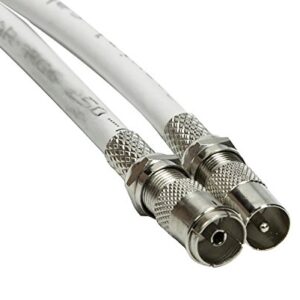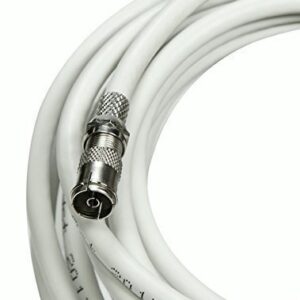TV Aerial Cable
A TV aerial cable, also known as a coaxial cable, is a type of cable used to transmit the signals from a TV aerial to a TV set. The cable serves as a link between the aerial and the TV, allowing the viewer to receive clear and high-quality television signals.
TV Aerial Cable
A TV aerial cable typically consists of an inner conductor, an insulating material, a braided metal shield, and an outer covering. The inner conductor is usually made of copper and carries the electrical signals from the aerial to the TV set. The insulating material surrounds the inner conductor, preventing it from coming into contact with the metal shield and other conductive materials. The braided metal shield acts as a Faraday cage, which protects the inner conductor from electromagnetic interference (EMI) and radio frequency interference (RFI). Finally, the outer covering provides protection against damage and moisture.
When choosing a TV aerial cable, it is important to consider several factors, including the length of the cable, the frequency range of the signals, and the cable’s loss factor. The length of the cable affects the strength of the signal, with longer cables having a weaker signal. For this reason, it is recommended to choose a cable that is as short as possible. The frequency range of the signals determines the cable’s frequency response and its ability to transfer the signals over the required range. Finally, the loss factor, also known as cable attenuation, refers to the amount of signal loss that occurs as the signal travels through the cable. This is expressed in decibels per meter (dB/m) and is dependent on the frequency of the signal and the cable’s design.
When installing a TV aerial cable, it is important to follow a few basic guidelines to ensure the best performance. Firstly, the cable should be properly grounded to prevent EMI and RFI from affecting the signal quality. Secondly, the cable should be properly secured to prevent it from moving and causing damage. Finally, the cable should be properly connected to the aerial and the TV set to ensure a good electrical connection.
There are different types of TV aerial cables available, each with its own unique features and performance characteristics. Some of the most common types of TV aerial cables include RG-6, RG-59, and RG-11. RG-6 is a common type of cable used for satellite and cable TV installations. It is suitable for high-frequency signals and provides low signal loss. RG-59 is a type of cable that is commonly used for analog TV installations and is suitable for signals with frequencies up to 600 MHz. RG-11 is a type of cable that is designed for long-distance installations and provides low signal loss over long distances.
In addition to coaxial cables, there are also other types of cables that can be used for TV installations. For example, fiber optic cables are increasingly being used for TV installations due to their high bandwidth and low signal loss. Fiber optic cables transmit signals using light, which allows them to transfer large amounts of data over long distances. This makes them ideal for digital TV installations, where high-quality signals are required.
TV aerial cables are an essential component of any TV installation, providing a link between the aerial and the TV set. When choosing and installing a TV aerial cable, it is important to consider factors such as the length of the cable, the frequency range of the signals, and the cable’s loss factor. With the proper selection and installation, a TV aerial cable can provide high-quality signals for an enjoyable viewing experience.
Customers who used 5starcables.com to buy a TV Aerial Cable have rated the site 5 out of 5 from 1 reviews on reviews.co.uk. ★★★★★


